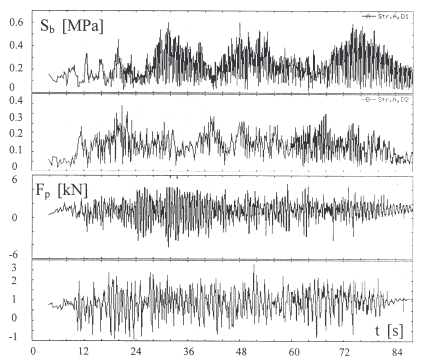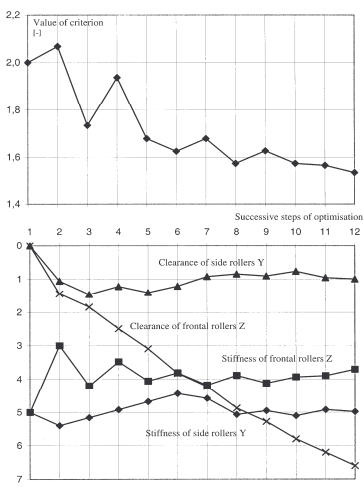Optimisation of dynamic features of mine hoisting systems
Автор: Tejszerska D.
Источник: 10th jubilee international scientific conference ACHIEVEMENTS IN MECHANICAL & MATERIALS ENGINEERING 2001
Аннотация
Tejszerska D. Optimisation of dynamic features of mine hoisting systems Разработана отдельная опция, позволяющая оптимизировать динамические характеристики системы подъемной машины. В статье представлен метод оптимизации, результаты и общие выводы.
The mathematical model and computer program, simulating electro–mechanic processes in mine hoisting systems, elaborated by author and presented in several publications was developed. Separate option, enabling optimisation of dynamic features of the system was introduced. Method of optimisation, exemplary results and general conclusions are presented.
1. Introduction
Preparation of numerical models and computer programs, simulating phenomena, occurring in complex, non–linear objects, became one of the most popular methods of studying their behaviour, enabling determination of influence of different working conditions and optimisation of process and design parameters. Modern numerical methods and computer hardware enable the formulation and solution of complex models, more and more accurately representing processes occurring in a real system, and allowing its precise qualitative and quantitative evaluation. This method is specially effective in investigation of such objects, as dynamics of mine hoisting system, which have well–known description of partial physical phenomena and very scarce possibility of changing design and process parameters for performing experimental optimising research of the whole object.
Serious dynamic interactions occur in elements of hoisting systems, during normal operation and in emergency states. Their evaluation and minimisation is important for increasing system life and safety, and decreasing margins of safety, masses and dimensions of elements.
Longitudinal vibrations, mainly dependent on processes of starting and braking, cause fatigue wear of ropes, which, apart from corrosion, is a main reason for necessity of their replacement. The vibrations increase the intensity of sliding of single ropes, which erode pulleys lining. Transverse vibrations, which depend on the design of cage and conditions of shaft guides, cause large forces, resulting in erosion of guides and fatigue wear of cage elements. Dynamic effects in emergency states can cause crash of the whole hoisting system.
The presented numerical non-linear model of hoisting system describes vibrations, caused by the stochastic distribution of irregularities of shaft guides and by the demanded tachogram of winding machine motion. Multirope system, with flexible cages, equipped with rollers and slide shoes, interacting with flexible shaft guides is analysed. Electromechanical properties of the winding machine and the action of controller, changing driving moment accordingly to determined tachogram are taken into account.
The non-linear phenomena connected with variations of load, carried by each rope, sliding of ropes and movement of suspension elements are included. The effects of variations of length of branches and stiffness of individual ropes, friction and internal damping as well as the possibility of system asymmetry are taken into account.
Complex form of interaction between rollers and guides, including existence of clearances or preliminary thrust, mating of rollers and slide shoes and various stiffness of shaft guides in the points of their contact with rollers are considered.
The coupling between two forms of vibrations is introduced, in the form of impact of dynamically varying forces in ropes - on the transverse vibrations, and of the friction forces, resulting from rollers interactions - on the longitudinal vibrations.
The elaborated mathematical model, defining dynamic behaviour of mine hoist, has the form of non-linear system of partial and ordinary differential equations. The model is solved numerically. Ropes are divided on one-dimensional finite elements and time derivatives are replaced by finite differences, giving the system of ordinary linear equations.
Coefficients of final linear equations are changed in every time step, regarding variations of parameters, sliding of ropes, movement of suspension elements, and specially the changes of conditions of contact of rollers and slide shoes with guides, which strongly vary effective stiffness. After determination of displacements in the end of time step the conditions of contact of every roller are checked. If they are different from initial - then the first time instant of their change is calculated. Interpolated values for this time are treated as initial for next time step.
Preliminary step of simulation consist in iterative calculation of the stationary positions of cages, necessary for avoiding the false dynamic excitation in the first period of motion.
Model and program was verified by comparison of the results of simulation with published experimental data, measured in the hoisting system with the same main design and process parameters, and good agreement was obtained.
2. Method of optimisation
The systematic analysis of influence of individual features of the object on its dynamics is performed, using separate options of program, provided for sensitivity analysis and optimisation. The analysis is performed by numeric gradient method. The gradients of criterion in the space of decisive design and process parameters are obtained by performing sequence of simulations of mine hoist motion, every with little changed value of one of decisive parameters. Gradient elements are calculated as the ratios of relative changes of criterion to relative changes of decisive parameters
Optimisation is performed in consecutive steps. Every step consists of sequence of process simulations with actual and slightly changed decisive parameters, of calculation of basic value of criterion and of its numerical gradients, as described above, and of the change of decisive parameters – proportionally to product of assumed maximal changes and appropriate elements of gradient. The sign of maximal change is changed and its value is reduced for these decisive parameters, which have negative appropriate elements of gradient. Optimisation is ended when gradient elements and maximal changes of decisive parameters became sufficiently small. Optionally the optimisation is repeated, starting from another basic values of decisive parameters, to avoid achievement of only local minimum.
Maximal and average values of stresses in ropes, rollers and elements of cages, amplitudes of their dynamic changes, maximal accelerations of cages in longitudinal and transverse directions, maximal driving moment, values of sliding of single ropes along the pulley and the time of the whole transport process are treated as criterial dynamic factors. Value of criterion is calculated as weighed sum of relative criterial factors, with weightsintroduced asinput data for every optimising calculation. Systematic sensitivity analysis, performed by the use of separate option of program enabled selection of the group of decisive structural and process parametrs, which have greatest influence on criterial factors. Considered parameters include maximal accelerations of start-up and braking, the time of increasing or decreasing of acceleration in the demanded tachogram of hoist motion, gain and time constants of winding machine controller, stiffness of rollers, clearances or preliminary thrust between rollers and slide shoes and shaft guides, and factors describing stochastic distribution of irregularities of shaft guides. Independent or joint analysis of parameters describing accelerations of start-up and braking, and of characteristics of side and frontal rollers are provided.
Systematic sensitivity analysis, performed by the use of separate option of program enabled selection of the group of decisive structural and process parametrs, which have greatest influence on criterial factors. Considered parameters include maximal accelerations of start-up and braking, the time of increasing or decreasing of acceleration in the demanded tachogram of hoist motion, gain and time constants of winding machine controller, stiffness of rollers, clearances or preliminary thrust between rollers and slide shoes and shaft guides, and factors describing stochastic distribution of irregularities of shaft guides. Independent or joint analysis of parameters describing accelerations of start-up and braking, and of characteristics of side and frontal rollers are provided.
3. Exemplary results of optimisation
Typical examples of successive steps of optimisation and some of its effects, are presented on fig. 1 and 2, for parameters influencing transverse vibrations, with lowering value of criterion and presented criterial parameters and variously changing values of decisive parameters.

Fig. 1. Example of influence of optimisation on stresses in cage beams ( Sb) and forces in side rollers (Fp) A – before optimisation , B – after optimisation of system parameters

Fig. 2. Example of optimisation process
4. Conclusions
Elaborated model and computer program enable simulation of vibrations of hoisting systems, facilitating the selection of optimal parameters of designed hoisting systems as well as improvement of existing systems operation.
Quantitative results of optimisation strongly depend on the whole combination of structural and process parameters of mine hoist, but qualitative conclusions, regarding properties of the system and possibility of optimisation have more general character. The following are most important.
Optimisation of gain of winding machine controller, decrease of maximal values of acceleration in demanded tachogram of hoist motion, elongation of time of growth and falling of this acceleration, and specially transition from stepwise to trapezoid form of demanded graph of acceleration causes great reduction of amplitudes of oscillations of accelerations of cages, considerable decrease of driving moment and maximal accelerations, and appreciable reduction of amplitudes of oscillations of stresses in ropes, decreasing their fatigue wear. Changes of maximal stresses in ropes are relatively small. Reduction of vibrations is bound with some elongation of global transportation time, so optimisation of dynamic properties of hoist must consider actual level of reserves of capacity of shaft.
Influence of stiffness of rollers and nominal clearances between rollers and guides is considerable, and optimisation can decrease maximal forces in rollers more than twice. Optimal parameters of rollers, different for frontal and side rollers, depend on cage mass and magnitude of irregularities of guides.
References
- Tejszerska D., Switoski E., Mezyk A.: Dynamika wielolinowych ukladow wyciagowych. Grant KBN PBU 7 T07C 03013. Gliwice 2000.
- Tejszerska D., Switoski E.: Modelling of vibrations of hoisting systems. European Congr.on Computational Methods in Applied Sciences and Engineering. Barcelona, 2000.
- Switoski E, Tejszerska D., Mezyk A.: Sensitivity analysis of dynamic stresses in ropes in mine hoisting system. 11-th Intern.Conf. Investigation, production & use of steel wire ropes. Podbanske, 2000.
- Kleiber A.: Komputerowe metody mechaniki cial stalych, PWN-Warszawa 1995.